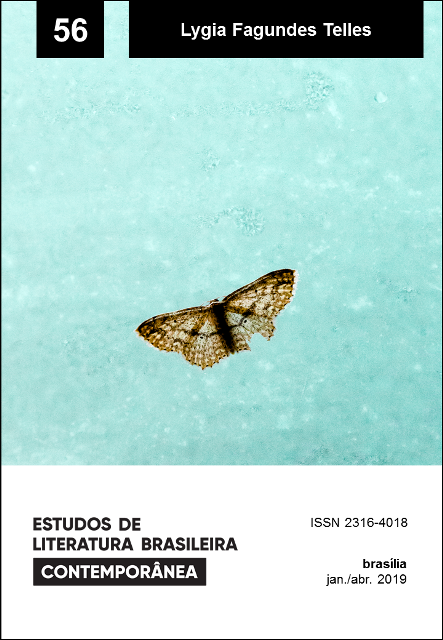Rags that comfort: feminine aging in Lygia Fagundes Telles
DOI:
https://doi.org/10.1590/2316-4018569Keywords:
Lygia Fagundes Telles, Naked hours, (As horas nuas), old age, literatureAbstract
Lygia Fagundes Telles published As horas nuas (Naked Hours) in 1989, introducing Rosa Ambrósio, an outstanding character who faces the daily life of old age after a career dedicated to art. An actress and an interpreter of life, Rosa Ambrósio, after leaving the stage, feels herself being interpreted from the perspective of other people’s prejudices: the look they direct towards her now sees the other in her, the elderly woman, about whom it is common to have a generalized and stereotyped opinion or to have no opinion at all, an indifference that spares the reader the fear of looking. The figure of Rosa Ambrósio personifies a trajectory from the stage to oblivion, from public to private. Observing her journey allows for a glimpse at the importance of literature’s mediating exercise to raise awareness about how we deal with old age, especially with female aging. Our analysis is based on the following questions: to what extent do the new roles now assumed by the elderly oppose stereotypes and prejudices, and to what extent do they revalidate, in new formats, pernicious positions that should have been overcome long ago? For the elaboration of this article, texts of Simone de Beauvoir, Ecléa Bosi and Robert Burtler were researched, which, although published in the 1960s and 1970s, are still references in the study of old age, as well as more recent publications such as those of Guita Debert, António Fonseca, Miriam Goldenberg and Sibila Marques, among others. It is concluded that the negative view of old age, if still strongly ingrained, has already proven to be a mistake, and that exclusionary stereotypes are beginning to be replaced by a gradual change of perspective, in part, a result of the expanding research in the area, involving different sectors, methods and approaches, and emphasizing the variety and inconclusiveness of definitions on the subject.
Downloads
References
BACHELARD, Gaston (2008). A poética do espaço. Tradução de Antonio de Pádua Danesi. São Paulo: Martins Fontes.
BEAUVOIR, Simone de (1990). A velhice. Tradução de Maria Helena Franco Monteiro. Rio de Janeiro: Nova Fronteira.
BOSI, Ecléa (1994). Memória e sociedade: lembranças dos velhos. São Paulo: Companhia das Letras.
BURTLER, Robert (1969). Age-Ism: another form of bigotry. The Gerontologist, Oxford, v. 9, n. 4, p. 243-246. Disponível em: https://academic.oup.com/gerontologist/article-abstract/9/4_Part_1/243/569551. Acesso em: 10 fev. 2018.
CARVALHO, Alfredo L. C. (2016). A fascinante ficção de Lygia Fagundes Telles: seis estudos críticos. São Paulo: Vitrine Literária.
DEBERT, Guita (1999). A reinvenção da velhice: socialização e processos de reprivatização do envelhecimento. São Paulo: Fapesp.
ELIAS, Norbert (2001). A solidão dos moribundos seguido de “Envelhecer e morrer”. Tradução de Plínio Dentzien. Rio de Janeiro: Zahar Editores.
FONSECA, António Manuel (Coord.) (2004). Desenvolvimento humano e envelhecimento. Lisboa: Climepsi.
GOLDENBERG, Miriam (2013). A bela velhice. São Paulo: Record.
MARQUES, Sibila (2011). Discriminação da Terceira Idade. Lisboa: FFMS.
PEIXOTO, Clarice (1998). Entre o estigma e a compaixão e os termos classificatórios: velho, velhote, idosos, terceira idade. In: BARROS, Myriam Moraes Lins de (Org.). Velhice ou terceira idade? Rio de Janeiro: FGV. p. 69-84.
RODRIGUES, José Carlos (2006). Tabu da morte. Rio de Janeiro: Fiocruz.
SONTAG, Susan (1972). The double standard of aging. The Saturday Review, New York, p. 29-38, 23 Sep.
TELLES, Lygia Fagundes (1998). Seminário dos ratos. Rio de Janeiro: Rocco.
TELLES, Lygia Fagundes (1999). As horas nuas. Rio de Janeiro: Rocco.
TELLES, Lygia Fagundes (2009). A noite escura e mais eu. São Paulo: Companhia das Letras.
Published
How to Cite
Issue
Section
License
Authors who publish in this journal agree to the following terms:
a) The authors maintain the copyright and grant the journal the right of first publication, the work being simultaneously licensed under the Creative Commons Attribution License-Non Commercial 4.0 which allows the sharing of the work with acknowledgment of the authorship of the work and publication this journal.
b) Authors are authorized to enter into additional contracts separately, for non-exclusive distribution of the version of the work published in this journal (eg publish in institutional repository or as a book chapter), with authorship recognition and publication in this journal.
c) Authors are allowed and encouraged to publish and distribute their work online (eg in institutional repositories or on their personal page) after the editorial process, as this can generate productive changes, as well as increase the impact and citation of published work (See The Effect of Free Access).
d) The authors of the approved works authorize the magazine to, after publication, transfer its content for reproduction in content crawlers, virtual libraries and the like.
e) The authors assume that the texts submitted to the publication are of their original creation, being fully responsible for their content in the event of possible opposition by third parties.


